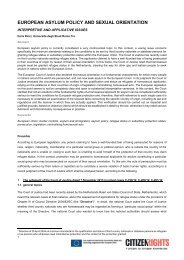AEMI
AEMI-2016-web
AEMI-2016-web
Create successful ePaper yourself
Turn your PDF publications into a flip-book with our unique Google optimized e-Paper software.
136 <strong>AEMI</strong> JOURNAL 2015<br />
ples pour tens of thousands of dollars<br />
into infertility treatments in frenzied<br />
attempts to become pregnant’ (Ibid.:<br />
407). However, treatment fails for about<br />
thirty five percent of infertile couples in<br />
developed countries. Such couples may<br />
then turn to ICA as their last chance to<br />
create a family (Ibid.: 408).<br />
In addition to the social and demographic<br />
changes in developed countries,<br />
there are long-term processes in developing<br />
nations that come into the equation.<br />
The same factors that drive irregular<br />
migration to the US and the European<br />
Union are creating significant numbers<br />
of adoptable children: a high incidence of<br />
poverty, poor governance or downright<br />
failed states, restrictive abortion regulations,<br />
high fertility rates and unplanned<br />
births. It is a great paradox of our times<br />
that the youngest migrants are welcome<br />
whereas those who seek to migrate on<br />
their own account, i.e. when they are<br />
older, are not. In sum, the structural demand<br />
for children comes from developed<br />
countries and the structural supply from<br />
underdeveloped ones (Graff, 2008). ICA<br />
has gradually been shaped by demand<br />
and supply, which belied its humanitarian<br />
and altruistic nature especially when<br />
it became infected with large amounts of<br />
money. Thus, as Graff states, ‘unless we<br />
recognize that behind the altruistic veneer,<br />
international adoption has become<br />
an industry -- one that is often highly<br />
lucrative and sometimes corrupt -- many<br />
more adoption stories will have unhappy<br />
endings’ (Ibid.: 66).<br />
Selman (2013) has analyzed the recent<br />
tendencies in ICA and identified<br />
several factors and trends behind the<br />
numbers. Table 1 shows the ICAs from<br />
2003 to 2012 for 23 receiving states. As<br />
Table 1 demonstrates, the global number<br />
of ICAs peaked in 2004 with around<br />
45,000 children.









